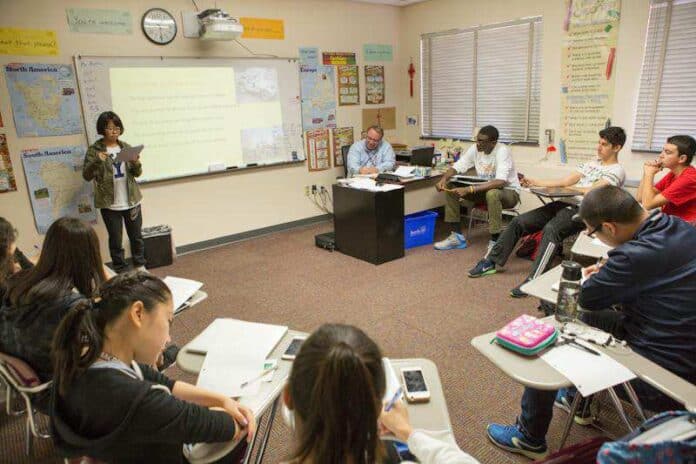
In the ever-evolving landscape of education, the design of learning environments plays a pivotal role in shaping student experiences. Collaborative spaces have emerged as a powerful tool in fostering teamwork, communication, and creativity within schools.
This blog explores the significance of collaborative spaces in educational settings, the benefits they bring to student learning, and the key elements that contribute to their success.
Key Elements of Collaborative Spaces
Flexible Furniture and Layouts
The physical layout of a collaborative space is a crucial element in promoting teamwork. Flexible furniture that can be easily rearranged facilitates different group configurations, allowing for large discussions, small group work, and individual reflection.
Mobile desks and a variety of school chairs empower students to create their ideal learning environment, adapting it to suit their collaborative needs.
All these and other multi-purpose and ergonomic furniture contribute to a flexible layout that can be easily reconfigured to accommodate diverse teaching methodologies, promoting an agile and dynamic learning environment.
Technology Integration for Seamless Communication
In the digital age, technology plays a central role in collaborative learning. Integrating smartboards, interactive displays, and online collaboration tools enables seamless communication and information sharing.
Students can collaborate on projects in real-time, even if they are physically distant. This integration prepares students for a tech-driven future while enhancing the efficiency and effectiveness of collaborative activities.
Inspirational Design and Color Psychology
The aesthetics of a space significantly impact the mood and mindset of its occupants. Collaborative spaces designed with vibrant colors, inspiring artwork, and natural light create a positive and energizing atmosphere.
Color psychology is leveraged to stimulate creativity, focus, and calmness, contributing to an environment conducive to effective collaboration and learning.
Benefits of Collaborative Spaces
Fostering Teamwork and Communication
Collaborative spaces break down traditional classroom barriers, encouraging students to work together on projects, share ideas, and engage in meaningful discussions. This fosters a sense of teamwork and collaboration that goes beyond individual achievements.
Students learn to leverage each other’s strengths, navigate differences, and collectively contribute to a shared goal. As they collaborate, they develop essential interpersonal skills that are crucial not only in their academic journey but also in future careers.
Enhancing Creativity and Problem-Solving
The design of collaborative spaces prioritizes creativity by providing an environment that stimulates innovative thinking. Flexible furniture arrangements and interactive technologies create a dynamic atmosphere where students can brainstorm, experiment, and explore new ideas.
This emphasis on creativity extends beyond artistic expression to problem-solving in various subjects. Collaborative spaces become hubs of innovation, where students learn to approach challenges with inventive solutions.
Improving Student Engagement and Motivation
Students’ engagement and motivation levels soar when they actively participate in the learning process. Collaborative spaces provide an antidote to traditional lecture-style teaching, allowing for hands-on, interactive experiences.
Students feel a sense of ownership over their learning, contributing to a positive and empowering educational experience. This increased engagement has a ripple effect on academic performance, attendance, and overall satisfaction with the learning process.
Involving Teachers in Collaborative Space Design
Gathering Input and Feedback from Educators
Teachers are integral stakeholders in the collaborative learning process, and their insights are invaluable in designing effective spaces. Gathering input and feedback from educators ensures that the collaborative environment meets the practical needs of teaching while aligning with pedagogical goals.
Training and Professional Development for Effective Use
Equipping teachers with the necessary skills to leverage collaborative spaces is crucial. Training and professional development programs provide educators with the tools and strategies to maximize the potential of these environments, ensuring that collaborative learning becomes an integral part of their teaching methodology.
Creating Spaces that Support Different Learning Styles
Students have diverse learning styles, and effective collaborative spaces cater to these variations. Designing spaces that accommodate visual, auditory, and kinesthetic learners ensures that all students can actively participate and contribute to collaborative activities in a way that suits their individual preferences.
Collaborative Spaces and Remote Learning
Adapting Collaborative Environments to Virtual Platforms
The global shift to remote and hybrid learning models necessitates the adaptation of collaborative environments to virtual platforms. Technological solutions that facilitate online collaboration and communication become essential in maintaining the benefits of collaborative learning, even in a digital setting.
Utilizing Technology for Remote Teamwork
Video conferencing tools, collaborative platforms, and virtual whiteboards become integral components of remote collaborative learning. Teachers and students alike must adapt to these technologies to maintain effective teamwork and communication, bridging the gap between physical and virtual collaborative spaces.
Ensuring Inclusivity in Hybrid Learning Environments
Ensuring inclusivity in collaborative spaces becomes paramount as educational institutions navigate hybrid learning models. Providing equal opportunities for both in-person and virtual students to participate actively fosters a sense of belonging and collaboration, regardless of their physical location.
Overcoming Challenges in Collaborative Space Design
Budget Constraints and Cost-Effective Solutions
Budget constraints often pose challenges in designing collaborative spaces, but innovative solutions exist. Schools can explore cost-effective furniture options, repurpose existing spaces, and seek community partnerships to overcome financial barriers while still creating effective collaborative environments.
Addressing Noise and Distractions
One common concern in collaborative spaces is the potential for increased noise levels and distractions. Design strategies, such as acoustic panels, designated quiet zones, and clear guidelines on respectful behavior, can mitigate these challenges and create a harmonious collaborative learning environment.
Balancing Individual Focus with Collaborative Activities
Finding the right balance between individual-focused tasks and collaborative activities is essential. Collaborative spaces should be designed to accommodate both modes of learning, allowing students to transition seamlessly between independent work and group projects.
Measuring the Impact on Student Success
Assessing Academic Performance in Collaborative Environments
Measuring the impact of collaborative spaces on student success involves assessing academic performance. Comparative studies, standardized test scores, and grade improvements can provide valuable insights into the effectiveness of collaborative learning environments.
Gathering Feedback from Teachers and Students
Feedback from teachers and students is a crucial component of evaluating the impact of collaborative spaces. Surveys, interviews, and focus group discussions can reveal qualitative data on the perceived benefits, challenges, and overall satisfaction with collaborative learning environments.
Long-Term Benefits for Skill Development and Future Careers
Beyond immediate academic outcomes, collaborative spaces contribute to long-term benefits by fostering skill development. Collaboration enhances communication, critical thinking, and problem-solving skills, preparing students for success not only in their academic journey but also in their future careers.
Future Trends in Collaborative Space Design
Evolving Technologies and Their Role in Education
As technology advances, future collaborative space design trends will likely be shaped by innovative educational technologies. Virtual and augmented reality, artificial intelligence, and interactive learning tools will be more prominent in creating immersive and dynamic collaborative environments.
Sustainable and Eco-Friendly Design Practices
Sustainability is an emerging trend in educational facility design, and collaborative spaces are no exception. Future designs will likely incorporate eco-friendly materials, energy-efficient solutions, and sustainable practices to create environments that align with broader environmental stewardship goals.
Flexibility to Adapt to Changing Educational Needs
The future of collaborative space design will prioritize flexibility to adapt to changing educational needs. Spaces that can easily transition between traditional, collaborative, and virtual learning modes will become more prevalent, ensuring that educational environments remain responsive to evolving pedagogical approaches.

By incorporating key design elements, involving teachers in the process, adapting to remote learning, overcoming challenges, and measuring the impact on student success, educational institutions can create environments that prepare students for the challenges and opportunities of the future.
As we look ahead to future trends, the evolving landscape of collaborative space design promises innovative, sustainable, and flexible solutions that will continue to shape the educational experiences of generations to come.





